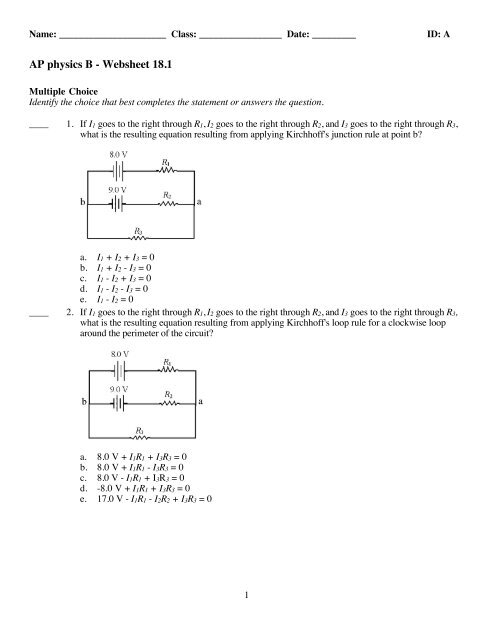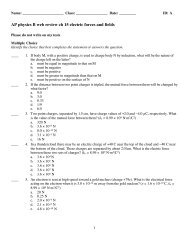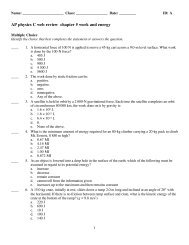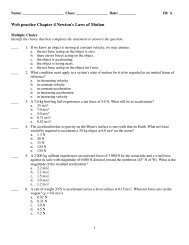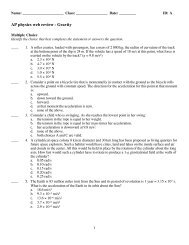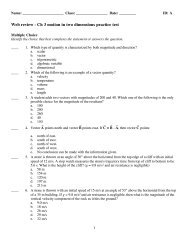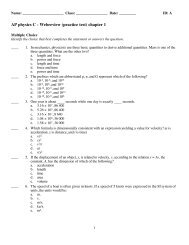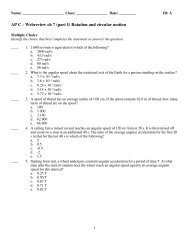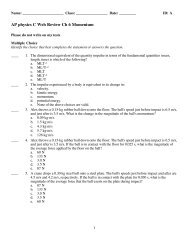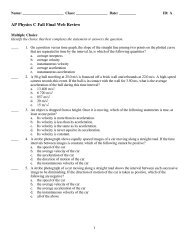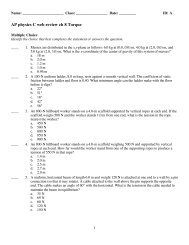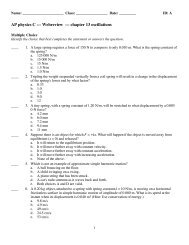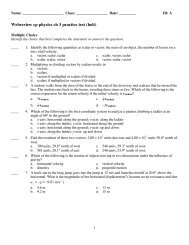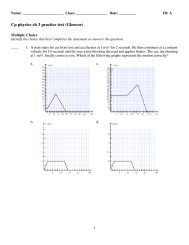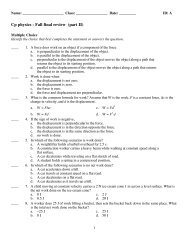AP physics B - Websheet 18.1
AP physics B - Websheet 18.1 - Planet Holloway
AP physics B - Websheet 18.1 - Planet Holloway
- No tags were found...
You also want an ePaper? Increase the reach of your titles
YUMPU automatically turns print PDFs into web optimized ePapers that Google loves.
Name: ______________________ Class: _________________ Date: _________<br />
ID: A<br />
<strong>AP</strong> <strong>physics</strong> B - <strong>Websheet</strong> <strong>18.1</strong><br />
Multiple Choice<br />
Identify the choice that best completes the statement or answers the question.<br />
____ 1. If I1 goes to the right through R1, I2 goes to the right through R2, and I3 goes to the right through R3,<br />
what is the resulting equation resulting from applying Kirchhoff's junction rule at point b?<br />
a. I1 + I2 + I3 = 0<br />
b. I1 + I2 - I3 = 0<br />
c. I1 - I2 + I3 = 0<br />
d. I1 - I2 - I3 = 0<br />
e. I1 - I2 = 0<br />
____ 2. If I1 goes to the right through R1, I2 goes to the right through R2, and I3 goes to the right through R3,<br />
what is the resulting equation resulting from applying Kirchhoff's loop rule for a clockwise loop<br />
around the perimeter of the circuit?<br />
a. 8.0 V + I1R1 + I3R3 = 0<br />
b. 8.0 V + I1R1 - I3R3 = 0<br />
c. 8.0 V - I1R1 + I3R3 = 0<br />
d. -8.0 V + I1R1 + I3R3 = 0<br />
e. 17.0 V - I1R1 - I2R2 + I3R3 = 0<br />
1
Name: ______________________<br />
ID: A<br />
____<br />
3. What is the current through the 2-Ω resistor?<br />
____<br />
a. 1.0 A<br />
b. 0.50 A<br />
c. 1.5 A<br />
d. 2.0 A<br />
e. 2.5 A<br />
4. What is the current through the 8-Ω resistor?<br />
a. 1.0 A<br />
b. 0.50 A<br />
c. 1.5 A<br />
d. 2.0 A<br />
e. 2.5 A<br />
2
Name: ______________________<br />
ID: A<br />
____ 5. What is the potential difference between points a and b?<br />
____<br />
a. 6 V<br />
b. 8 V<br />
c. 12 V<br />
d. 24 V<br />
e. 27 V<br />
6. What is the current flowing through the 2-Ω resistor?<br />
a. 2 A<br />
b. 3 A<br />
c. 4 A<br />
d. 6 A<br />
e. 7 A<br />
3
Name: ______________________<br />
ID: A<br />
____<br />
7. What is the current flowing through the 4-Ω resistor?<br />
____<br />
____<br />
a. 1 A<br />
b. 2 A<br />
c. 3 A<br />
d. 6 A<br />
e. 9 A<br />
8. In a circuit, a current of 2.0 A is drawn from a battery. The current then divides and passes through<br />
two resistors in parallel. One of the resistors has a value of 64 Ω and the current through it is 0.40 A.<br />
What is the value of the other resistor?<br />
a. 8.0 Ω<br />
b. 16 Ω<br />
c. 24 Ω<br />
d. 32 Ω<br />
e. 40 Ω<br />
9. In the circuit segment shown if I = 7 mA and Q = 50 µC, what is the potential difference, VA − VB?<br />
a. −40 V<br />
b. +40 V<br />
c. +20 V<br />
d. −20 V<br />
e. −15 V<br />
4
Name: ______________________<br />
ID: A<br />
____<br />
10. If I = 2.0 mA and the potential difference, VA - VB = +30 V in the circuit segment shown, determine<br />
the charge and polarity of the capacitor.<br />
____<br />
____<br />
a. 1.5 mC, left plate is positive<br />
b. 1.5 mC, right plate is positive<br />
c. 0.50 mC, left plate is positive<br />
d. 0.50 mC, right plate is positive<br />
e. 1.0 mC, left plate is positive<br />
11. If one doubles the emfs in a circuit and doubles the resistances in the circuit at the same time, what<br />
happens to the currents through the resistors? Assume there are only emfs and resistors in the circuit.<br />
a. They stay the same.<br />
b. They double.<br />
c. They quadruple.<br />
d. They halve.<br />
e. They increase by a factor of 8.<br />
.<br />
12. A 10-V-emf battery is connected in series with the following: a 2-µF capacitor, a 2-Ω resistor, an<br />
ammeter, and a switch, initially open; a voltmeter is connected in parallel across the capacitor. At the<br />
instant the switch is closed, what are the current and capacitor voltage readings, respectively?<br />
a. zero A, 10 V<br />
b. zero A, zero V<br />
c. 5 A, zero V<br />
d. 5 A, 10 V<br />
e. 20 A, 10 V<br />
5
Name: ______________________<br />
ID: A<br />
____<br />
13. A 10-V-emf battery is connected in series with the following: a 2-µF capacitor, a 2-Ω resistor, an<br />
ammeter, and a switch, initially open; a voltmeter is connected in parallel across the capacitor. After<br />
the switch has been closed for a relatively long period (several seconds, say), what are the current and<br />
capacitor voltage readings, respectively?<br />
____<br />
a. zero A, 10 V<br />
b. zero A, zero V<br />
c. 5 A, zero V<br />
d. 5 A, 10 V<br />
e. 20 A, 10 V<br />
14. A circuit contains a 6.0-V battery, a 4.0-Ω resistor, a 0.60-µF capacitor, an ammeter, and a switch all<br />
in series. What will be the current reading immediately after the switch is closed?<br />
____<br />
a. zero<br />
b. 0.75 A<br />
c. 1.5 A<br />
d. 10 A<br />
e. 24 A<br />
15. A circuit contains a 6.0-V battery, a 4.0-Ω resistor, a 0.60-µF capacitor, an ammeter, and a switch in<br />
series. What will be the charge on the capacitor 10 min after the switch is closed?<br />
a. zero<br />
b. 0.10 µC<br />
c. 3.6 µC<br />
d. 2.4 µC<br />
e. 1.2 µC<br />
6
Name: ______________________<br />
ID: A<br />
____<br />
16. A 1 000-V battery, a 3 000-Ω resistor and a 0.50-µF capacitor are connected in series with a switch.<br />
The capacitor is initially uncharged. What is the value of the current the moment after the switch is<br />
closed?<br />
____<br />
a. 0.39 A<br />
b. 0.33 A<br />
c. 0.84 A<br />
d. 2 000 A<br />
e. 1.0 A<br />
17. A 1 000-V battery, a 3 000-Ω resistor and a 0.50-µF capacitor are connected in series with a switch.<br />
The time constant for such a circuit, designated by the Greek letter, τ, is defined as the time required<br />
to charge the capacitor to 63% of its capacity after the switch is closed. What is the value of τ for this<br />
circuit?<br />
____<br />
a. 6.0 × 10 9 s<br />
b. 1.7 × 10 −10 s<br />
c. 1.7 × 10 −7 s<br />
d. 1.5 × 10 −3 s<br />
e. 1.5 × 10 −1 s<br />
18. A 1 000-V battery, a 3 000-Ω resistor and a 0.50-µF capacitor are connected in series with a switch.<br />
The time constant for such a circuit, designated by the Greek letter, τ, is defined as the time that the<br />
capacitor takes to charge to 63% of its capacity after the switch is closed. What is the current in the<br />
circuit at a time interval of τ seconds after the switch has been closed?<br />
a. 0.14 A<br />
b. 0.21 A<br />
c. 0.12 A<br />
d. 0.32 A<br />
e. 0.18 A<br />
7
Name: ______________________<br />
ID: A<br />
____<br />
____<br />
19. The following three appliances are connected to a 120-V house circuit: i) toaster, 1 200 W, ii) coffee<br />
pot, 750 W, and iii) microwave, 800 W. If all were operated at the same time, what total current would<br />
they draw?<br />
a. 3.0 A<br />
b. 5.0 A<br />
c. 10 A<br />
d. 23 A<br />
e. 31 A<br />
20. What is the maximum number of 60-W light bulbs you can connect in parallel in a 120-V home<br />
circuit without tripping the 30-A circuit breaker?<br />
a. 11<br />
b. 35<br />
c. 59<br />
d. 3 600<br />
e. 6 800<br />
8
ID: A<br />
<strong>AP</strong> <strong>physics</strong> B - <strong>Websheet</strong> <strong>18.1</strong><br />
Answer Section<br />
MULTIPLE CHOICE<br />
1. A<br />
2. C<br />
3. A<br />
4. C<br />
5. C<br />
6. C<br />
7. A<br />
8. B<br />
9. D<br />
10. A<br />
11. A<br />
12. C<br />
13. A<br />
14. C<br />
15. C<br />
16. B<br />
17. D<br />
18. C<br />
19. D<br />
20. C<br />
1


